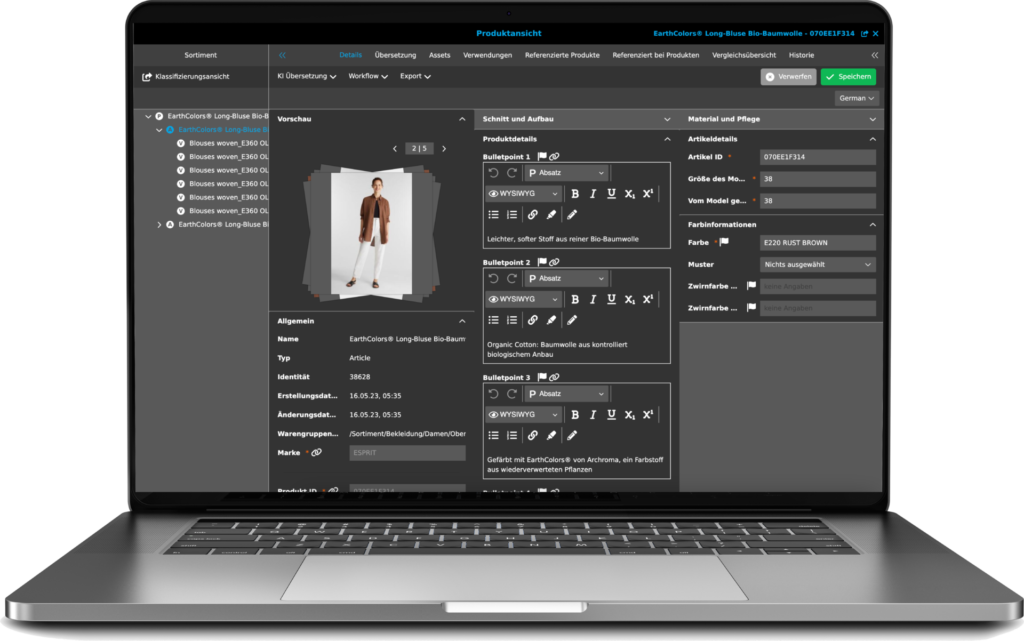Why PIM is not possible with Excel
Product Information MANAGEMENT
For many companies, Excel spreadsheets are still the tried and tested method for managing their product information. However, if you look at the current requirements that companies have to meet when marketing their products, the limitations of Excel in product information management become increasingly apparent. A change in methodology is all the more urgent as the major players have long been using PIM systems as the basis for their product communication and marketing strategies. In this blog article, you can find out why Excel sheets have fallen out of date as a solution for PIM and why specialized PIM software covers precisely this need.
You have probably already asked yourself whether managing product data in your company using Excel is really still up to date. The tool is well known and new employees can usually work with it without much introduction and maintain the individual product data in the tables. However, when it comes to product information management, which includes not only internal administration but also the provision and maintenance of product data in the sales channels, Excel doesn’t have much more to offer – and also brings with it a number of problems. That’s why, in this blog post, we’re not just looking at the problem areas of Excel – the inefficient work processes, the potential for errors during manual data entry and the lost marketing potential of your product data. We also explain which specific features and tools a PIM system offers for precisely these challenges.
Excel stumbling blocks in product communication
Managing product data with Excel comes with numerous process-based inefficiencies – on both a small and large scale. If you want to organize specific product data in a meaningful way and categorize, sort or filter it into product families, for example, you will already notice Excel’s lack of functions in this respect. In addition, internal communication about product information is made more difficult by the fact that the data is stored in fragmented tables, which in turn are circulated in various departments with little transparency. This results in inconsistencies in the product data that are difficult to trace, and corrections of purely human errors become an ongoing organizational task. This shortcoming makes the decision to switch to a PIM system all the more urgent.
PIM systems can contain your company’s entire product data inventory in a structured form at a single point of intersection. Centralizing data management in this way not only saves resources, but also has a positive effect on the quality of data and collaboration between departments – be it marketing, sales, customer service or product development.
Qualitative product information requires more than just tables
A major uncertainty factor for Excel is the fact that even cloud-based applications such as Google Sheets or Sharepoints do not guarantee high-quality product data and, in the worst case, could even violate security guidelines. Because the manual management of this data with Excel often takes place without centralized quality assurance, product information is often stored in tables unnoticed, incorrectly, incompletely or out of date. In addition, qualitative product data is ultimately defined by the fact that it offers customers competitive purchasing experiences using visually appealing media formats – a quality standard that Excel cannot meet.
This is offset by the numerous advantages of PIM as a single source of truth in the company, in which information from all data sources is consolidated. With real-time updates across the entire platform, PIM systems prevent your company from inadvertently having different product data in circulation. The product information runs through automated validation processes – based on predefined rules and standards – in which quality defects are quickly identified. With regard to your various sales and communication channels, PIM systems can also provide all relevant product data immediately so that the requirements of these channels can be adapted in real time. A PIM system can also support data exchange with business partners such as suppliers and retailers or data pools such as the GS1 GDSN and automatically convert the data into the required versions and formats. Delays in product marketing can thus be avoided.
The advantages of PIM systems over Excel spreadsheets at a glance

Collaboration options
With a PIM system, all your employees can access your company’s product data and exchange information via the system. Integrated role and rights management, together with a workflow engine, ensures structure and order in the work processes, while validation rules and approval levels ensure quality after each work step.

360-degree view of products
A PIM system provides your employees with a comprehensive overview of all your products and the associated product information. The functions of the PIM system include the basic and more technical master data as well as the editorially prepared product descriptions, marketing texts and rich product content (e.g. instructions for use).

Process efficiency
With a PIM system that automates recurring manual work steps, your employees need to invest significantly less procedural effort to process the product data for the various application contexts and make it available at the touchpoints. The product data is stored in granular form and can be easily merged with communication elements such as marketing slogans or images from the DAM to create product content, which can then be used for specific channels.

Assured data quality
PIM systems not only enable the onboarding of quality-assured data. As the linchpin for managing and controlling product data, a PIM system covers the entire life cycle of product content and thus gradually ensures the quality of every product communication. This requires strong data governance, which allows you to define the quality requirements within your company and regulate the handling of product data.
Excel versus PIM as the basis for your product communication
The way in which product data is managed in the company has far-reaching consequences. As Excel data management involves an ongoing, cross-departmental effort, there is often a lack of resources to consider marketing factors in the context of product communication or to fulfill or ensure internal and external quality requirements. A PIM system can help here.
PIM systems ensure the correct distribution and presentation of product information across different channels and touchpoints – and therefore also form the technological basis for omnichannel marketing. It is important that the underlying data model of the system is optimally tailored to your company and industry-specific requirements.
About OMN PIM
With OMN PIM you can collect, structure and process product data from various sources. Regardless of whether the data comes from external or internal sources. Created specifically for product information, OMN PIM is therefore the ideal place for all your product data along the entire supply chain. Whether master data, specifications, materials, manufacturing processes or product compliance details, OMN PIM bundles and links them all in a central location. Structured digital processes and functions for data governance and version control ensure transparency, sustainability and compliance in your DPP development. See the power of OMN PIM for yourself and be well prepared when the digital product passport arrives.

Would you like to get to know our OMN PIM?
EXPERIENCE OUR PIM LIVE AND SEE ITS PERFORMANCE FOR YOURSELF!